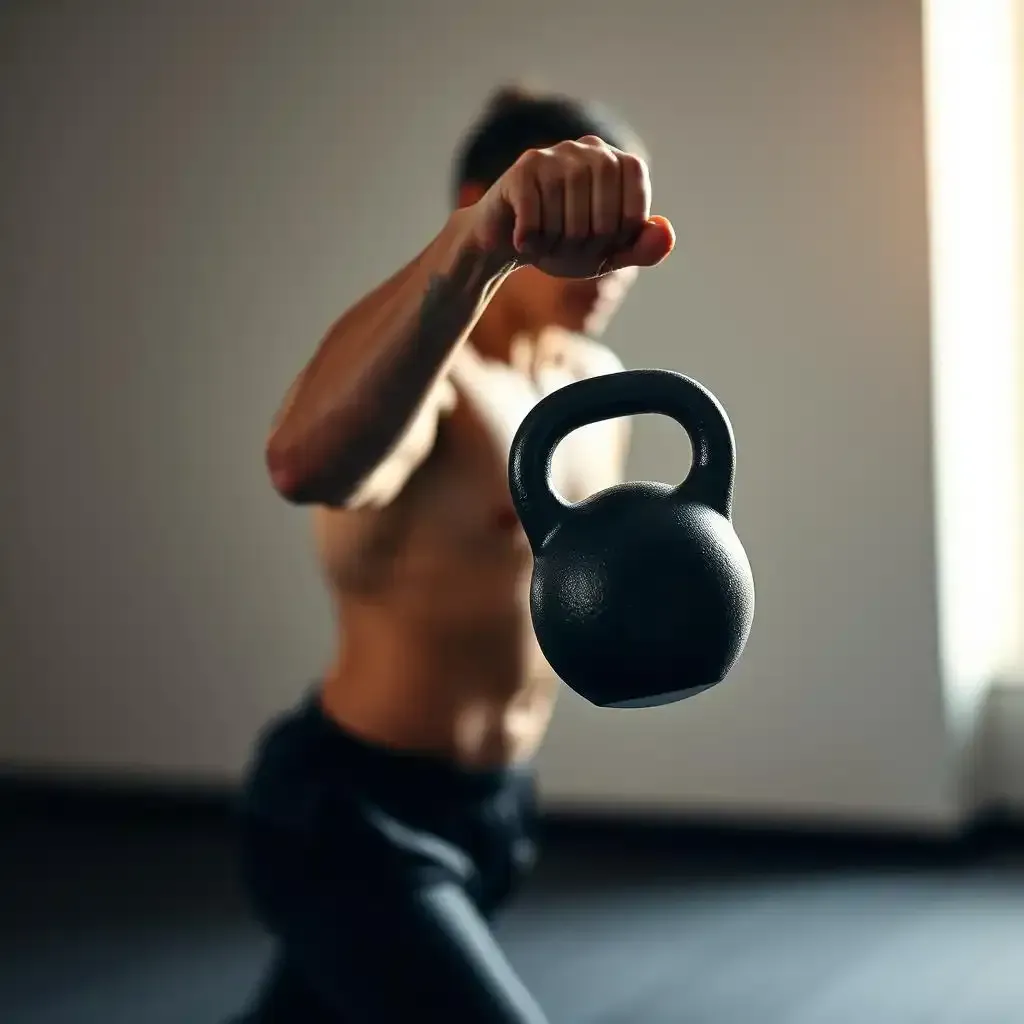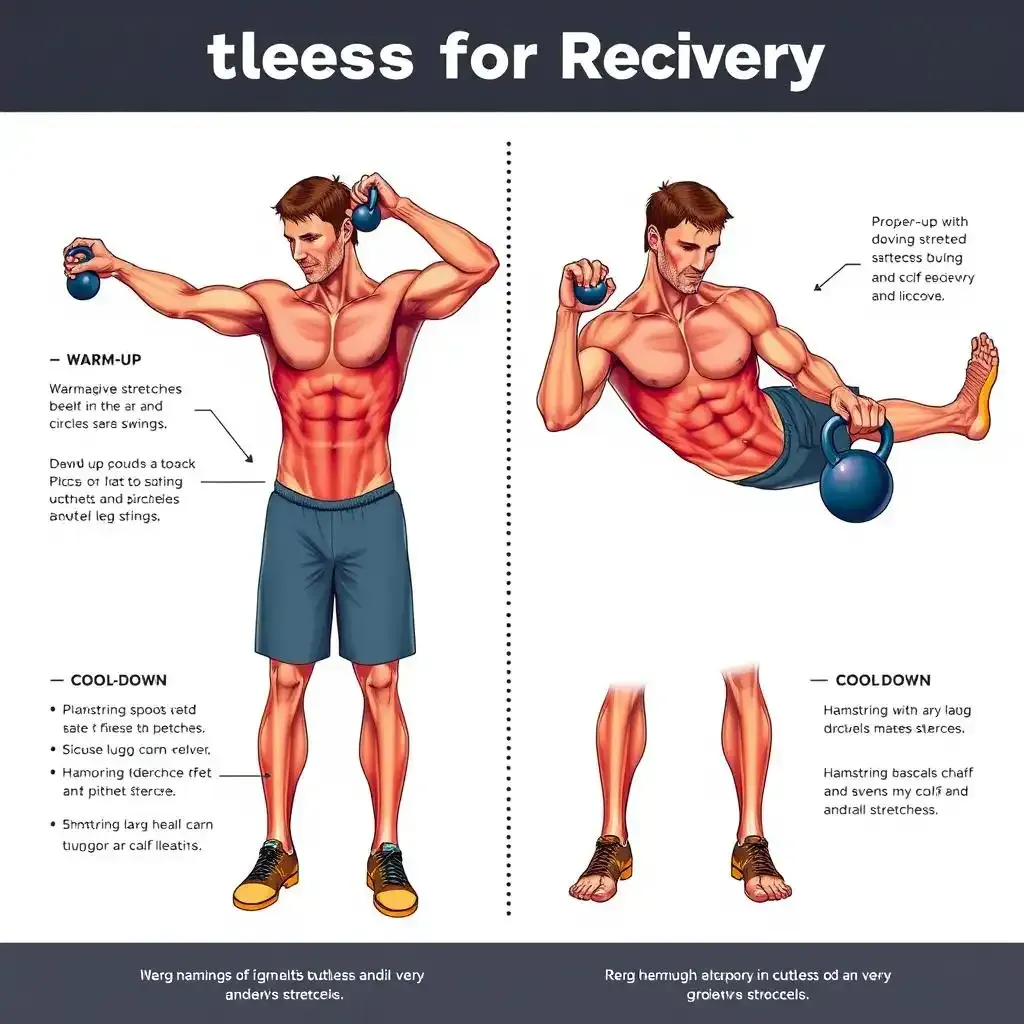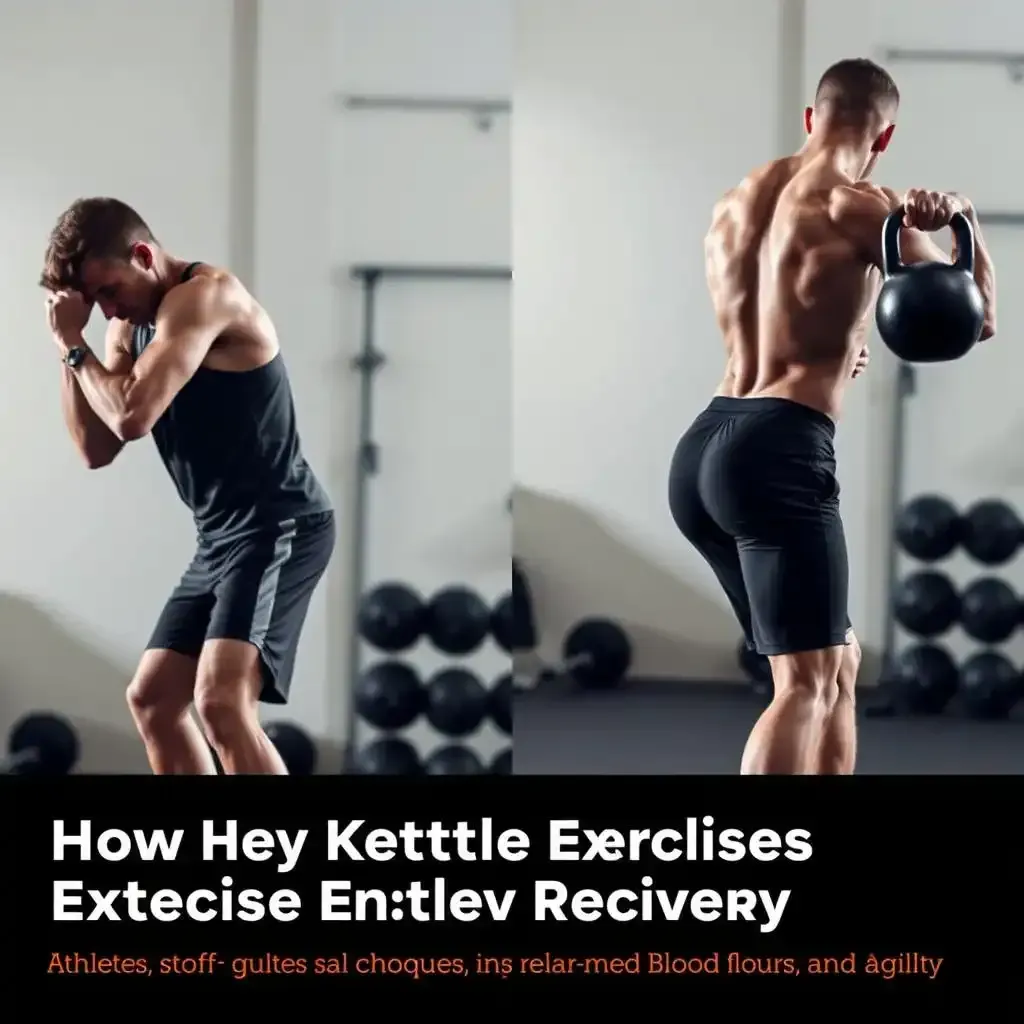Table of Contents
Recovering from intense workouts is just as important as the workouts themselves. While rest days are crucial, active recovery can help your body heal more effectively and come back stronger. Kettlebell exercises, in particular, are a fantastic way to aid in this recovery process. They promote mobility, improve circulation, and enhance overall strength and stability. In this article, we will explore the best kettlebell exercises for recovery, provide practical tips, and explain how these exercises can enhance your recovery. Whether you're a seasoned athlete or a fitness enthusiast, these insights from kettlebellworkout.homes will help you optimize your recovery routine and stay in top form. So, let's examine in and find how kettlebell exercises can revolutionize your recovery!
Kettlebell Exercises for Recovery: The Basics

Kettlebell Exercises For Recovery The Basics
Hey there, fellow fitness enthusiast! So you're diving into the world of kettlebell exercises for recovery? Awesome! I've been using kettlebells for years, and let me tell you, they're a game-changer for active recovery. Think of them as your secret weapon against post-workout soreness. They're not just about lifting heavy; they're about smart movement that helps your body bounce back faster. It's like giving your muscles a gentle massage with a little bit of a challenge thrown in. You're not aiming for exhaustion, but rather a boost in blood flow to flush out those lactic acid build-ups. It's all about feeling good, not just looking good!
One thing I love about kettlebells is their versatility. Unlike some super-specialized equipment, you can use them for a full-body workout, hitting multiple muscle groups at once. This is key for recovery, because it helps to keep everything balanced and prevents stiffness. It’s like a mini-workout that's customized specifically for your body's needs after a tough session. Imagine this: you just crushed a leg day, and your quads are screaming. Instead of collapsing on the couch, you grab your kettlebells and do some gentle swings. The blood flow gets going, and suddenly those quads feel a bit less grumpy. It's magic, I tell you!
- Improved blood circulation
- Increased muscle flexibility
- Enhanced range of motion
Now, before you rush off to grab your kettlebells, remember that form is everything. Check out our guide to proper kettlebell form to avoid injuries. It's like learning to ride a bike – you need to get the basics right before you can go full speed. Trust me, starting with the right technique prevents those annoying aches and pains that can derail your progress. This is crucial, especially when you’re using kettlebells for recovery.
For beginners, I highly recommend starting with lighter weights. Don't try to be a hero on your first day. It's more about the quality of the movement than the quantity of the weight. Think of it like this: you wouldn't try to run a marathon on your first day of jogging, right? Start slow, build up gradually, and you'll see amazing results. Plus, remember that even small improvements can make a big difference in your recovery trip. Consistency is key!
Kettlebell Exercise | Benefits for Recovery |
|---|---|
Kettlebell Swings | Improves hip mobility, increases blood flow |
Goblet Squats | Strengthens legs and core, improves posture |
Kettlebell Rows | Strengthens back muscles, improves upper body posture |
Best Kettlebell Exercises for Recovery
Alright, let's talk specifics! Some of my favorite kettlebell exercises for recovery are surprisingly simple. They focus on controlled movements that promote flexibility and blood flow, without putting too much stress on your muscles. Remember, the goal here isn’t to build massive muscle but to help your body heal and prepare for the next workout. It’s about getting your body back on track!
Kettlebell swings are a fantastic all-around exercise. They work your entire posterior chain – your glutes, hamstrings, and back – which are often neglected. Think of it as a full-body massage for your back side! And, as a bonus, it gets your heart rate up a little, boosting circulation. You can find more tips on easy kettlebell exercises to get you started.
- Kettlebell Swings
- Goblet Squats
- Turkish Get-Ups
Goblet squats are another great option. They’re a variation of the classic squat, but holding the kettlebell close to your chest adds a bit of extra core engagement. This is important because a strong core is the foundation of good posture and injury prevention. It's like building a strong base for your entire body. I find them incredibly effective for relieving lower back tension after a long day.
Finally, don't underestimate the ability of simple arm exercises. Kettlebell presses and rows are excellent for improving upper body strength and mobility. Remember, even small movements can help to increase blood flow and reduce muscle stiffness. We have a great guide on kettlebell exercises for arms if you're interested in learning more.
Tips for Using Kettlebells in Recovery
So, you've chosen your exercises. Now, let’s talk strategy. Remember, recovery workouts are different from your regular intense sessions. Keep your reps lower, focus on perfect form, and listen to your body. It's like a gentle tune-up for your machine, not a race to the finish line. Don't overdo it! You’re aiming for a gentle boost, not another grueling session.
Start with a warm-up. This could be some light cardio, like jogging in place, followed by dynamic stretches. Think arm circles, leg swings, and torso twists. It's like getting your engine ready before you start driving. Proper warm-up is essential for injury prevention. You can find some excellent kettlebell warm-up exercises on our site.
- Prioritize proper form over speed.
- Listen to your body and stop if you feel pain.
- Don't be afraid to use lighter weights.
After your kettlebell workout, remember to cool down with some static stretches. Hold each stretch for 20-30 seconds. It's like gently unwinding your muscles after a workout. This helps to improve flexibility and reduce muscle soreness. I often incorporate some yoga or Pilates to enhance the relaxation process. It's the perfect way to end your recovery session.
Hydration is also crucial. Drink plenty of water throughout the day, especially before, during, and after your workout. It's like giving your body the fuel it needs to repair itself. Dehydration can lead to muscle cramps and fatigue, so staying hydrated is essential for optimal recovery. You can find more information on kettlebell hydration tips to stay well-hydrated.
Warm-up | Workout | Cool-down |
|---|---|---|
5 minutes of light cardio | 15-20 minutes of kettlebell exercises | 5 minutes of static stretches |
How Kettlebell Exercises Enhance Recovery
So, why are kettlebells so great for recovery? It all comes down to the science. These exercises promote blood flow, which helps to flush out metabolic waste products that build up in your muscles after intense workouts. It’s like giving your muscles a ability wash! This reduction in waste products reduces soreness and speeds up the healing process.
Kettlebell exercises also improve your range of motion and flexibility. Tight muscles are often the culprits behind post-workout aches. By gently moving your joints through their full range of motion, you can improve flexibility and reduce stiffness. It’s like oiling the hinges of your body. This helps prevent future injuries and improves your overall performance. For more information on improving your flexibility, check out our kettlebell exercises for flexibility guide.
- Improved blood flow
- Increased range of motion
- Reduced muscle soreness
- Improved recovery time
And finally, the mental benefits are just as important. Active recovery can help to reduce stress and improve your mood. It's a chance to connect with your body and focus on your well-being. It’s like a mini-meditation session that leaves you feeling refreshed and ready to tackle the next challenge. For more information on how kettlebells can help you recover, check out our kettlebell recovery methods article.
Remember, recovery is an active process, not just a passive one. By incorporating kettlebell exercises into your routine, you're not just treating the symptoms, you're addressing the root cause of muscle soreness and fatigue. It's about building a sustainable fitness process, not just chasing quick fixes. So, go ahead and give those kettlebells a whirl – your body will thank you for it!
Best Kettlebell Exercises for Recovery

Best Kettlebell Exercises For Recovery
Okay, so you're ready to examine into the best kettlebell exercises for recovery? Awesome! I'm buzzing with excitement to share my favorites. These aren't your typical muscle-building behemoths; these are smart, targeted moves designed to help your body repair itself after a tough workout. Think of it like giving your muscles a supercharged massage, but with a bit more oomph. You're not aiming for exhaustion, just a gentle push to get that blood flowing and those happy endorphins pumping. It's all about feeling amazing, not just looking amazing!
One of my absolute go-to moves is the kettlebell swing. It's deceptively simple, but it works wonders. You'll feel it in your glutes, hamstrings, and back—areas often neglected in other exercises. It's like a full-body massage for your backside! Plus, it gets your heart rate up slightly, boosting circulation. It’s a fantastic way to start your recovery workout, and it’s also great for building strength. Check out our guide if you're a beginner.
- Kettlebell Swings
- Goblet Squats
- Turkish Get-Ups
Next up: goblet squats. These are like regular squats, but you hold the kettlebell close to your chest, engaging your core. A strong core is your body's secret weapon against injury, so this is a big deal. I find goblet squats incredibly effective for easing lower back tension. It's like giving your spine a hug! Goblet squats are an amazing exercise for building leg strength and improving overall stability.
Don't underestimate the capability of simple arm exercises either! Kettlebell presses and rows are amazing for upper body strength and mobility. Even small movements like these increase blood flow and reduce muscle stiffness. It's like giving your arms a gentle wake-up call. We have a fantastic guide on to help you improve your upper body strength and flexibility.
Exercise | Muscle Groups Worked | Recovery Benefits |
|---|---|---|
Kettlebell Swings | Glutes, Hamstrings, Back | Improved blood flow, increased mobility |
Goblet Squats | Quads, Glutes, Core | Strengthens legs and core, improves posture |
Kettlebell Rows | Back, Biceps, Forearms | Strengthens back muscles, improves upper body posture |
And finally, let's not forget Turkish get-ups. These are a bit more challenging, but they're fantastic for overall body control and stability. They're like a full-body coordination challenge, and they’ll leave you feeling incredibly balanced and strong. This is a great exercise to improve your core strength, shoulder stability, and hip mobility.
Remember, recovery isn't about crushing yourself; it's about smart movement. Start with lighter weights, focus on perfect form (check out our !), and listen to your body. It's a gentle tune-up, not a race! You're aiming for a gentle boost, not another grueling session.
I love how versatile kettlebells are! They’re perfect for a quick active recovery session, and you can easily adapt them to your fitness level and goals. Don't forget to warm up before and cool down after your workout. It’s like prepping your car engine before a road trip. You can find some great here.
Tips for Using Kettlebells in Recovery

Tips For Using Kettlebells In Recovery
Warm-up Like a Pro
Hey there, fellow fitness friend! Before you even THINK about grabbing those kettlebells, let's talk warm-up. This isn't some optional extra; it's your body's pre-game show, getting everything ready for the main event. A good warm-up is like tuning up your car engine before a long drive – you wouldn't just jump in and floor it, would you? Think of it as priming your muscles, lubricating your joints, and getting your blood flowing. No sudden jerky movements; we're going nice and smooth here. Five minutes of light cardio, like a brisk walk or some jumping jacks, is a great start. Then, follow it up with some dynamic stretches—arm circles, leg swings, torso twists—to get those muscles moving and feeling loose. Think of it as waking up your muscles gently. Check out our guide to for more ideas.
- Light cardio (5 minutes)
- Dynamic stretches (5 minutes)
Cool-Down and Stretch
Your recovery workout's not over until you've properly cooled down. This is your chance to unwind those muscles, prevent stiffness, and help your body recover more effectively. Think of it as giving your muscles a nice, relaxing massage after a long day. After your kettlebell session, spend five to ten minutes doing some static stretches, holding each one for about 20-30 seconds. Focus on the muscle groups you worked. Some gentle yoga or Pilates moves can also be a fantastic addition to your cool-down routine. It's like giving your body a big hug and saying, "Thanks for working hard!" Don't skip this crucial step; it'll make all the difference in how you feel the next day. You can find some great cool-down exercises to help you relax.
Muscle Group | Stretch |
|---|---|
Hamstrings | Standing hamstring stretch |
Quads | Standing quad stretch |
Calves | Standing calf stretch |
How Kettlebell Exercises Enhance Recovery

How Kettlebell Exercises Enhance Recovery
Kettlebell exercises are like a secret weapon for recovery. They're not just about building muscle; they're about helping your body heal and feel better. When you do a tough workout, your muscles get tiny little tears. Kettlebell exercises help patch those tears faster by improving blood flow and flexibility.
- Improved blood flow
- Increased range of motion
- Reduced muscle soreness
Think of it like this: after a long run, your legs feel stiff and sore. Kettlebell swings are like a gentle massage that gets your blood moving and reduces that stiffness. It's like giving your muscles a drink of water when they're thirsty.
Kettlebells also help with your range of motion. If you're tight in certain areas, these exercises can help you move more freely. For example, if you sit at a desk all day, your hips can get really tight. Goblet squats can help you loosen up and feel more comfortable.
Exercise | Muscle Groups Worked | Recovery Benefits |
|---|---|---|
Kettlebell Swings | Glutes, Hamstrings, Back | Improved blood flow, increased mobility |
Goblet Squats | Quads, Glutes, Core | Strengthens legs and core, improves posture |
Kettlebell Rows | Back, Biceps, Forearms | Strengthens back muscles, improves upper body posture |
Another great thing about kettlebells is that they help prevent future injuries. By keeping your muscles and joints flexible and strong, you're less likely to get hurt. It's like a little insurance policy for your body. For example, if you play a sport like basketball, kettlebell exercises can help you stay agile and strong, reducing the risk of sprains and strains.
And let's not forget the mental benefits. Active recovery with kettlebells can boost your mood and reduce stress. It's a chance to connect with your body and feel good. It's like a mini-meditation session that leaves you feeling refreshed and ready to tackle the next challenge.
Final Thought
Incorporating kettlebell exercises into your recovery routine can make a significant difference in how you feel and perform. By focusing on dynamic, controlled movements and proper form, you can enhance your recovery, prevent injuries, and come back stronger for your next workout. Remember, active recovery is not about pushing yourself to the limit but about helping your body heal and maintain its strength. So, give these kettlebell exercises a try and experience the benefits for yourself. Stay tuned to kettlebellworkout.homes for more fitness insights and tips.